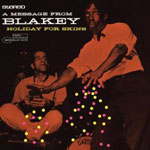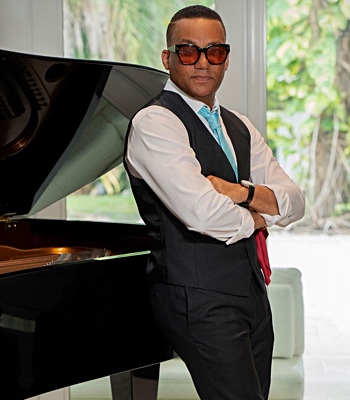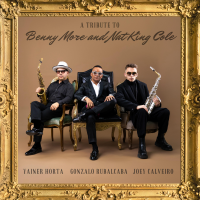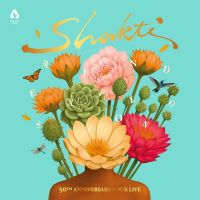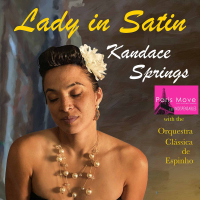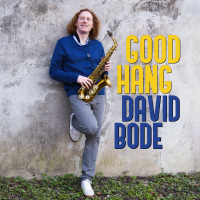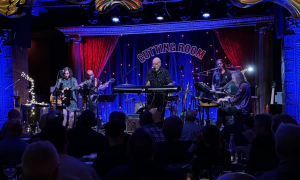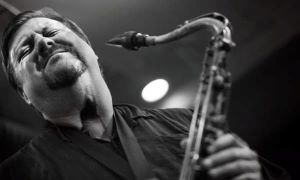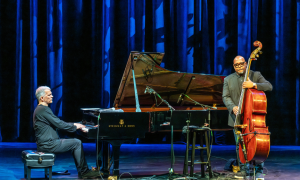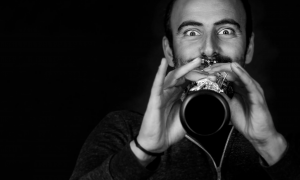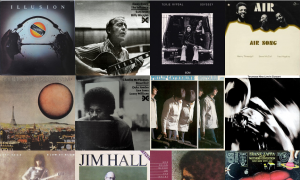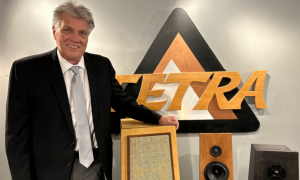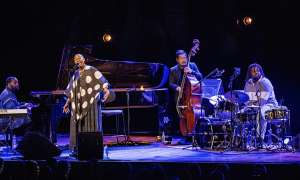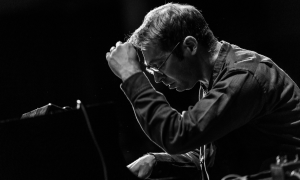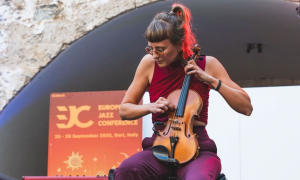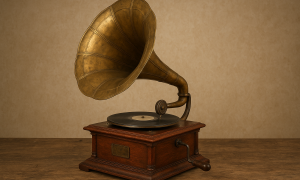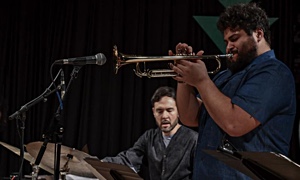Home » Jazz Articles » Live Review » Day 4 - Ottawa International Jazz Festival, June 25, 2006
Day 4 - Ottawa International Jazz Festival, June 25, 2006
The diversity of jazz is one of its most appealing qualities. Some practitioners aim for improvisation around written forms that range from bare sketches to detailed complexity. Others prefer to live life on the edge, performing completely improvised music without a safety net. Day four of the TD Canada Trust Ottawa International Jazz Festival provided a cross-section of artists, ranging from the relatively accessible and form- based piano trio of Robert Glasper to the total spontaneity of trumpeter Brad Turner and percussionist Dylan van der Schyff—and the music of Dutch trombonist Joost Buist and his group, which straddle the boundaries somewhere between the two but add a complexion all their own.
 Glasper is Blue Note's latest piano signing, the label's first since Jason Moran in the late 1990s, and there's been a lot of buzz surrounding his first recording for the label, Canvas (Blue Note, 2005). Much has been written about his fresh and contemporary approach to the piano trio, and there's no doubt that Glasper—supported in concert by bassist Vicente Archer and drummer Damion Reid—occupies territory shared by both modernists like Brad Mehldau and traditionalists like Bill Evans.
Glasper is Blue Note's latest piano signing, the label's first since Jason Moran in the late 1990s, and there's been a lot of buzz surrounding his first recording for the label, Canvas (Blue Note, 2005). Much has been written about his fresh and contemporary approach to the piano trio, and there's no doubt that Glasper—supported in concert by bassist Vicente Archer and drummer Damion Reid—occupies territory shared by both modernists like Brad Mehldau and traditionalists like Bill Evans. While expectations were high for Glasper's first appearance in Ottawa, he got off to a tentative start with a nevertheless elegant look at Sam Rivers' "Beatrice. His command of the instrument was strong, but his touch was almost too light, even with Reid's responsive dynamics and open ears. Archer kept things firm underneath, but the connection just didn't seem to be there. Despite Glasper's clear lyrical sensibility, the first half of the set was perhaps too inward-looking. And while one wouldn't expect high energy on tunes like these, one might have expected the group to go for it a little more.
As an interesting side note, this is the third show where veteran Ottawa bassist John Geggie has loaned his instrument to a festival performer—proof that more than the instrument itself, a player's touch and even physiology have a significant impact on his or her sound. It was interesting to contrast Archer's tone with that of bassist Hans Glawischnig, who borrowed the instrument for the Miguel Zenón show on the festival's opening day. Glawischnig hit more in the gut, while Archer—an equally fine player—didn't have the same visceral punch.
Glasper may be a young player with a contemporary bent, but he's as rooted in the tradition as players twice his age, making a brief reference to "Satin Doll at one point during a solo. He successfully linked the old and the new, seamlessly segueing from Dave Brubeck to Stevie Wonder halfway through the set, where the trio finally seemed to coalesce and kick into high gear.
 When speaking to the audience, Glasper seemed as tentative as his playing for most of the performance. Perhaps it's just the pressure of being thrust into the spotlight too quickly, but it wasn't until the second half of the set that the members of the trio seemed to relax and really start hearing each other. And it was only on the set's last two tunes—the gentle ballad "If These Were Words and the energetic "I Told You So"—where the musicians started to look like they were having some real fun. Reid, loose and intuitive throughout the set, became more animated and powerful, pulling Glasper and Archer along. Glasper's playing became more assertive, giving the other two players something stronger to hang onto, and it was unfortunate that Glasper chose to end the show at this point.
When speaking to the audience, Glasper seemed as tentative as his playing for most of the performance. Perhaps it's just the pressure of being thrust into the spotlight too quickly, but it wasn't until the second half of the set that the members of the trio seemed to relax and really start hearing each other. And it was only on the set's last two tunes—the gentle ballad "If These Were Words and the energetic "I Told You So"—where the musicians started to look like they were having some real fun. Reid, loose and intuitive throughout the set, became more animated and powerful, pulling Glasper and Archer along. Glasper's playing became more assertive, giving the other two players something stronger to hang onto, and it was unfortunate that Glasper chose to end the show at this point. Still, Robert Glasper is an artist who holds significant promise, and it will be interesting to see if he ultimately delivers on his potential.
In terms of intrepid reach, Brad Turner may well be Canada's answer to Dave Douglas. Unlike Douglas, however, the virtuosic trumpeter is also a fine keyboardist and drummer, and he has become a fixture on the Vancouver improvising scene. He's been involved in projects ranging from the Juno Award-winning fusion band Metalwood to the Americana (or, perhaps, Canadiana) roots music of Zubot & Dawson. But he's at his best in purely improvisational contexts, and so his duet performance with Vancouver percussionist Dylan van der Schyff—opening this year's 8 pm Improv Series at the National Arts Centre's Fourth Stage—was eagerly anticipated.
Van der Schyff has been gaining exposure as well, most notably for his work with artists like Dave Douglas, guitarist Ben Monder and cellist Peggy Lee—not to mention his own recent first album as a leader, The Definition of a Toy (Songlines, 2005). It was with Lee's band, in fact, that Turner and van der Schyff began playing together, and in the past seven years they've developed a simpatico that borders on telepathy.
Their Ottawa performance was as pared down as possible—Turner on trumpet and flugelhorn, van der Schyff on a conventional drum kit. But the music they made was anything but conventional, and the variety of textures they managed to extract from their instruments was uncanny. Van der Schyff was especially compelling to watch. He used virtually every part of the kit—from rubbing the wire on his brushes along a bolt on the bass drum to wetting his thumb and rubbing in on a drum skin to produce an otherworldly, almost singing tone.

Turner also extracted an infinite variety of textures from his horns. While there were periods of strong melody, he was equally likely to explore the diversity of sonic possibilities with but a single repeated note, breaking his instrument down to extract odd nasal tones or moving his horn around the microphone to create an phasing effect.
The show was an interesting contrast to the improvised set by pianist David Braid and clarinetist Phil Nimmons on the first evening of the festival. Where Braid and Nimmons, even at their most abstract, were aiming to construct pieces with broader themes, Turner and van der Schyff often stripped down the simplest of ideas to even more fundamental roots.
That's not to say there weren't periods of clear virtuosity. At times Van der Schyff would explode into bursts of high energy, his hands and/or sticks rushing around the kit in a frenzy. Turner, too, would occasionally deliver a rapid-fire flurry of notes in response to van der Schyff's extremes. They even alluded to swing at a few points; while their music may be free, it's not without its roots.
There are still listeners who believe that free improvisation is nothing more than a group of self-indulgent players meandering aimlessly. Turner and van der Schyff dismissed that misconception by delivering a seventy- minute set that may have drawn from a blank slate, but was never less than completely purposeful. In one of the few instances where Turner spoke to the capacity crowd, he said that this duo is the most liberating context for him. That may be true, but that shouldn't be mistaken for a lack of intention. Exploring a completely different side to unfettered exploration than Sonny Fortune and Rashied Ali's duets the day before, Turner and van der Schyff delivered a set that may have registered high on the abstraction scale, but was thoroughly captivating from start to finish.
Van der Schyff's day might have been finished with the 8 pm performance, but Turner—after playing no less than three dates in Vancouver the previous day and taking an overnight flight to Ottawa—was far from finished. Cornetist Felicity Provan was unable to make it for a cross-Canada tour, so Dutch trombonist Joost Buis recruited Turner for his performance at the 10:30 pm Studio Series with his eleven-piece Astronotes group. With only one rehearsal, Turner managed to fit into Buis' varied and often complex compositions as if he'd been there all along.
Joost Buis' Astronotes— featuring three saxophones, trumpet, trombone, guitar, piano, bass, drums and two percussionists— performed challenging music that still managed to be highly entertaining and engaging. Ranging from the sublime to the ridiculous, Buis' set combined abstract beauty and wacky absurdity—often within the same tune.
Highlighting anyone in the group in a review is difficult, since they were all such strong players— essential as parts of the ensemble, and capable of delivering solos that ranged from the evocative to the preposterous. Baritone saxophonist Frans Vermeerssen demonstrated a Ken Vandermark-like command of his instrument, often creating a percussive sound but equally capable of outer-reaching linear flight. Jan Willem van der Ham proved a fine altoist, but he shone the most when he picked up the bassoon. He is one of only a handful of artists who are capable of improvising on this extremely difficult instrument.

If personality defines musical style, then tenor saxophonist/clarinetist Tobias Delius was a perfect match for Buis himself, not to mention Michael Vatcher, whose strange setup of toy drums, tiny cymbals, duck calls and found objects contrasted with Alan Purves' more conventional kit—but unconventional and slapdash approach to rhythm.
Everyone in the group had an opportunity to shine during the performance, which sometimes took its cue from contemporary classical writing. Clarinet, alto sax and trumpet created Ligeti-like close voicings, while baritone, bassoon, trombone and tenor built a bottom-heavy tone that contrasted with the seemingly cluttered percussion layered over the top.
Pianist Achim Kaufman remained a harmonic support for most of the show, creating dense harmonic clusters, while guitarist Paul Pallesen's spare playing was at times seemingly invisible, but would have been missed had it not been there. Bassist Wilbert de Joode was capable of anchoring the music when necessary, but he was just as often an equal participant during passages of collective improvisation that were rooted in a form which may have been hard to latch onto, but was there nonetheless.
The absurdist element of the distinctive Dutch jazz scene dates back to the 1960s work of seminal artists like Han Bennink and Misha Mengleberg. Along with artists like woodwind players Ab Baars and Willem Breuker, Buis is keeping this wildly interdisciplinary and multicultural tradition alive. But by creating his own textural milieu, he creates a space all his own that continues to provide food for thought—and imagination—about jazz's greater possibilities.
Visit Robert Glasper, Brad Turner, Joost Buis and the TD Canada Trust Ottawa International Jazz Festival on the web.
Photo Credit
John Kelman
Tags
PREVIOUS / NEXT
Support All About Jazz
 All About Jazz has been a pillar of jazz since 1995, championing it as an art form and, more importantly, supporting the musicians who make it. Our enduring commitment has made "AAJ" one of the most culturally important websites of its kind, read by hundreds of thousands of fans, musicians and industry figures every month.
All About Jazz has been a pillar of jazz since 1995, championing it as an art form and, more importantly, supporting the musicians who make it. Our enduring commitment has made "AAJ" one of the most culturally important websites of its kind, read by hundreds of thousands of fans, musicians and industry figures every month.


